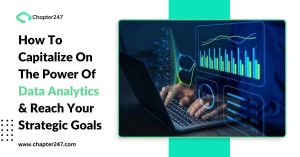Every business owner needs to understand the impact of what they do on a daily basis. By knowing what’s working, what’s not, and how to improve, any eCommerce store or multichannel brand can thrive. And thanks to today’s technology, that’s possible. It is important for all business enterprises irrespective of its size to have the power to make better decisions, understand and resonate with its customers on a deeper level, and run their businesses more efficiently.
The power of data is one of the biggest drivers of decision making for a Company. But the situation can get chaotic when no sense can be derived out of the data and that is where Business intelligence comes into play. Business Intelligence focuses on what’s happened in the past. It leverages software and services to transform data into actionable insights that educate the strategists of the organization to make tactical decisions regarding any trend observation. BI tools access and evaluate data, present analytical findings in reports, dashboards, summaries, charts, and maps to provide users the business with detailed intelligence.
Is your data lying there unattended?
A central facet of BI is reporting and the dashboard is the archetypal BI tool. We create dashboards as a hosted software application that automatically pulls together available data and puts them into understandable patterns of data and graphs.
Although business intelligence does not tell business users what to do or what will happen if they take a certain course. But remember BI is also not about just generating reports. Rather BI proffers a way for people to look at data to understand trends and derive insights by streamlining the efforts required to look for, merge, and query the data necessary to make data-based sound decisions.
For instance, a company that is looking to improve its supply chain requires BI capabilities to understand where delays are happening and where variabilities are happening within the shipping process. E-commerce Business Intelligence can also be used in such a case to understand which products are most commonly delayed and which modes of transportation are involved in most delays. With so much data available at your disposal companies usually have no inkling as to how the data can be used. When they are indifferent towards the data, there is insurmountable loss with respect to loss of potential insights the data could provide had it been used.
But what exactly makes up the company’s data?
Put simply, the data encompasses information on business operations, interests, and characteristics. Company data should be seen as a digital asset and could include any or all of the following:
- Leads and prospects
- Current customers and their behavior
- Sales and transactions
- Product details
- Marketing and advertising campaign data
- Process details, including order fulfillment and manufacturing
- Social media and engagement trends
- Records of interactions with customers, employees, and investors
- Employee data
- Financial data
- Market and competitor information
Steps to be taken to get the most out of E-commerce BI data
Data analysis forms a major part of BI, and when organizations are merely using the old-school methods, one can understand that the tools you have are lying waste. Reasons could range from not enough time to not enough resources to the worst which is not thinking they do not need detailed data evaluations. Organizations are also gathering lots of data and have lots of metrics but they have little or no idea what all of it means. They also lack the quality to put it all together to tell a cohesive story.
But without a proper Business intelligence strategy, Organizations large and small would have to bear the consequences of wasting unknown quantities of time and money on sales efforts, product efforts, marketing, and R&D because they do not have any idea where they should be putting in the effort to get the best ROI.
With all the resources available and tools at the disposal of the organizations there should be no excuses for them not to know who their audiences are, how to reach them, what they buy and what they will need in the future. To ensure your data is being put to good use and not getting piled up in some remote unreachable corner, we take a look at relevant questions that every organization should ask and get answers for to get the most from their business intelligence.
What is the kind of data you are collecting, and where is it coming from?
Data can come from so many sources, such as Advertising (digital, print, radio, etc.), email, social media, CRM programs, surveys and data gathering portals, web analytics and much more. Leaving out any of these prospective data generation areas or giving importance to the wrong ones can be harmful. When businesses weigh the sources, they need to ask, where is its bulk audience coming from and which source can give the most detailed and accurate analysis of its audience. It also needs to understand if they have missed out on any sources from where the audience could come. It is then important to link the data directly to what you do.
For instance if you are in the hospitality industry, it is important to know what people experience while on their stay on an ongoing basis. It is here that your organization can detect any issues early and score high on guest satisfaction rates boosting occupancy.
What about those businesses and people who come to you and the business is not able to account for them? These are some of the questions you will not be able to answer especially when the orders for your business are small or medium sized. If there are such questions emerging which your team is unable to answer then it is a clear case of missing data. You can consult us to help you and make sure that every nook and corner of data is scraped from places that matter. Our BI tools will help you recover data eliminating data losses to a large extent.
Missing pieces in the puzzle
Are there people or businesses coming to you and you are not able to account for them? Are there any questions related to your business and operations which you can’t answer? If the answer to both these questions is yes, then there is a cause of concern. If you tend to sideline small and medium scale business, then you will never be able to garner data. If your team cannot figure out where the missing pieces of data are hiding then it is time to rope in the services of a consultancy firm to help you.
Deep-seated integration
After collecting the numbers and analytics from all the different sources, you are finally in a position to see how the data works together. Integration is a key step that implies not just pulling the pieces together but also finding a meaningful way to present the data and continue to track it. We help you put together a dashboard that can integrate your data for you because integrating data from disparate sources can be a tricky affair. Even in the presence of robust APIs which can make integrating cloud-based applications easier than before, there is still a lot of hard work involved in integrating different systems.
If you are involved in an industry which needs extra security and privacy such as eCommerce, healthcare, financial services and the mortgage industry, then there are extra barriers to overcome to integrate data sources with your current systems. Hence working with us who are familiar with industry regulations within your industry as well as the software and security applications will put you in a benefit zone.
What do the metrics mean?
This is the aha moment which you have been waiting for. It is that moment when all the data pieces finally come together and you find answers to the most pressing operational, marketing and business-related questions. Sometimes the answers will just emerge out but for others it will take some additional thought, analysis and consultation. Whether your data makes sense or you’re ready to run with the results or not, you will witness the areas you missed. And this step is not the end but the beginning because as the analytics start to pour in, you will need to monitor and analyze them regularly not only to achieve your initial goals but also to figure out the next step forward.
It is critical to read your metrics properly and to get the analysis right. You may also want to scale your BI processes and findings as appropriate across the enterprise. It is not advisable to silo the departments by making sure everyone has access to the information they need. Also make sure everyone has access to the same vision and picture that the data presents.
The sum of all things
Get the analytics that you need by following these steps. Organizations will get the most from its business intelligence initiatives by breaking down the processes into administrable chunks. Every step needs time and careful consideration. With our assistance we will reward you with feedback and will help you capture trends easily and on time without losing any customer.
Contact us for more information.







